3.1 Introduction
The word rhythm comes from the ancient Greek word "rhithmos", whose etymological root, "rhein", means "to flow". The term reminds us that the essence of rhythm is the sense of flow in music.
Man is immersed in time from the moment of birth and time appears to pass constantly. It is difficult, however, to think of time passing without doing so in terms of phenomena that have a beginning and an end: the passage of the seasons, day and night, the beating of our hearts (systole and diastole), the movements of our feet when we walk (left/right). This alternation of phenomena that recur periodically, whether fast or slow, is the fundamental measure of the flow of time in all life and human expression and is known as metre or pulse.
Music is born and develops in time and therefore needs, above all the other arts, the idea of rhythm which is fundamental to every musical idea.
3.2 Metre (or Pulse) and the Beat
Metre is characterised by a succession of regular rhythmic units in time called beats, which are organised into bars (or measures). The beats, according to their position within the bar, receive strong, weak or medium strong accents.
We use Italian terms to describe many aspects of music, including dynamics (or volume).
- So to denote a strong sound we use the Italian word for strong which is forte (abbreviated to f)
- To denote a medium strong sound we use the Italian expression mezzo forte (abbreviated to mf)
- To denote a weak (or soft) sound we use the Italian word for soft which is piano (abbreviated to p)
These letters, f, mf & p, are used in the explanation below.
For example, in a bar with two beats (duple time) the first will be strong and the second weak. In a bar with three beats (triple time) the first will be strong and the second and third weak (1).
| Duple time bar | 1st strong | 2nd weak | |
| Triple time bar | 1st strong | 2nd weak | 3rd weak |
From the combination of these two types of bar we can obtain new metres composed as follows: (2):
| Quadruple time bar | f-p-mf-p | duble+duble |
| Quintuple time bar (1) | f-p-mf-p-p | duble+triple |
| Quintuple time bar (2) | f-p-p-mf-p | triple+duble |
| Septuple time bar (1) | f-p-p-mf-p-mf-p | triple+duble+duble |
| Septuple time bar (2) | f-p-mf-p-p-mf-p | duble+triple+duble |
| Septuple time bar (3) | f-p-mf-p-mf-p-p | duble+duble+triple |
3.3 Subdivision of the beat - Simple and Compound metres
The metre in music is usually indicated by regular movements of the hand.
Metres are divided into:
- Simple metres: those in which the beat is subdivided into two parts.
- Compound metres: those in which the beat is subdivided into three parts.
In either case the first part of the beat is given greater stress than the remaining part or parts
3.4 Describing the metre - the Time Signature
The metre (usually known as the Time Signature) consists of two numbers, one above the other rather like a fraction, that appear at the beginning of a piece of music. The time signature conveys two important pieces of information.
a) It indicates the total length of the bar, expressed as a fraction of a semibreve.
For example, the time signature "3/4" tells us that the bar is three quarters of a semibreve long.

While the time signature "9/8" tells us that the bar is 9/8 of a semibreve long, or one and 1/8 semibreves long.

b) It indicates the number of beats in the bar and tells us what sort of beats they are. It will also tell us whether the metre is simple or compound.
If the metre is simple (often referred to as Simple Time) then the upper number will tell us how many beats there are in each bar and the lower number tells us the value of each beat (expressed as a fraction of a semibreve).
If the metre is compound (often referred to as Compound Time) then the upper number will tell us how many beat subdivisions there are in each bar and the lower number tells us the value of these subdivisions (again expressed as a fraction of a semibreve).
A bar in simple time:
Example: "three four"
The 3 indicates three beats
The 4 indicates the value of each beat (in this case a crotchet)
A bar in compound time:
Example: "six eight"
The 6 indicates six beat subdivisions
The 8 indicates the value of each subdivision (1/8 = quaver)
The commonest compound time signatures may be distinguished from simple time signatures by the value of the upper number which will always be a multiple of 3 (but not including 3 itself). (2).
The number of main beats in the bar may be worked out by dividing the upper number by three.
Let us look at some examples of compound time signatures:
6/8 is a compound time signature with two main beats (6 / 3 = 2 beats)
9/4 is a compound time signature with three main beats (9 / 3 = 3)
12/4 is a compound time signature with four main beats (12 / 3 = 4)
To sum up, the time signature tells us:
- The type of pulse (simple or compound);
- The number of beats in the bar;
- The type of beats (in simple time signatures) or the type of beat subdivisions (in compound time signatures). For example the beat in a time signature of 3/4 is a crotchet (1/4 of a semibreve), but the beat in a time signature of 9/8 is dotted crotchet (three quavers).
Simple time signatures may be transformed into compound time signatures by multiplying by 3/2.
Compound time signatures may be transformed into simple time signatures by dividing by 3/2.
For example:
"fourfour" multiplied by 3/2 becomes "twelve eight"
"twelve eight" divided by 3/2 becomes "four four"
The two time signatures in the example above indicate:
- equal number of beats in the bar (quadruple time);
- equal value of beat subdivision (the quaver 1/8);
- the value of the main beat, the crotchet in simple time and the dotted crotchet in compound time.
3.5 Irregular (or complex) time signatures.
Irregular time signatures are those which contain a mixture of simple and compound beats.
For example, the time signature 8/8 has three main beats and may be considered as the combination of:
3/8 + 3/8 + 2/8 = 8/8
This is the commonest grouping of beats for 8/8 (and is commonly found in Latin-American music, e.g. bossa nova) but clearly the beat containing just two quavers could easily be placed at the beginning of the bar:
2/8 + 3/8 + 3/8 = 8/8
...or it could be the middle beat:
3/8 + 2/8 + 3/8 = 8/8
The composer will indicate exactly how the bar subdivides. This will usually be done by the way in which the beat subdivisions are grouped within the bar but sometimes dotted barlines between beats may be used. Another method is to use the following kinds of notation at the beginning of the piece:
(2+2+3)/8 or (3+3+2+2)/8 or even 2/8+1/8
The time signature 10/8 may be considered as the combination of:
3/8 + 3/8 + 2/8 + 2/8.
Here again the groups of three and two may be ordered differently, as in the previous example.
Other irregular time signatures include:
1/4; 1/8; 24/16; 11/8; 18/16
It is also possible to have different time signatures on different staves within a score. Although this is more commonly found in contemporary scores a famous example is found in the party scene in Mozart's Don Giovanni.
3.6 Different ways of indicating the time signature.
In addition to the numerical notation described above some other ways of indicating time signatures are used:
The time signature 4/4 is described as "Common time" and may be indicated by the letter "C", or even simply the number "4 ":

In the same way the time signature 2/2 may be indicated by the letter "C" with a vertical line through it (known as "Cut common time") or simply with the number "2 ".

The symbol "C" derives from the old notation used in 1300. At this time a time signature of three beats, "tempus perfectum", was symbolised by a circle.
Time signatures of two or four beats, "tempus imperfectum", was indicated by an incomplete circle which therefore looked like the letter "C".
Another way of expressing the time signature is to write a note instead of the lower number:

Braille example
3.7 Some conventions of notation
Here are some of the main conventions of notation:
- The flags on notes should always be placed to the right of the stem.
-
If a note with stem is below the middle line of the staff then the stem goes upwards. If a note with stem is above the middle line of the staff then the stem goes downwards. The stems of notes on the middle line may go either up or down but will probably go in the same direction as adjacent notes. When several notes are beamed together in a group the direction will be determined by the note furthest from the middle line.
For example

-
Notes are beamed together in way that makes the beats and beat subdivisions of the bar clear.


-
Even rests, where possible, should make clear the beats and beat subdivisions of the bar.


-
Sometimes, in order to make the beats of the bar as clear as possible, it is advisable to use ties rather than dotted notes:

-
The beaming of notes to group them into beats is not always done when there is a sung text under the notes. In cases where the notes have different syllables underneath them they will not be grouped together. Not all composers observe this convention, some preferring to maintain the clarity of beat structure.

Table of time signatures
| Simple time signatures | Compound time signatures | ||||
| Time signature | Beats |
Subdivisions of beats |
Time signature | Beats |
Subdivisions of beats |
| 2/1 |  |
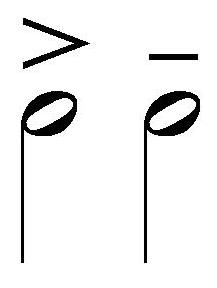 |
6/2 | 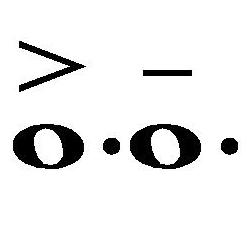 |
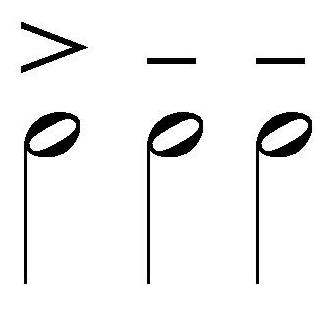 |
| 2/2 | 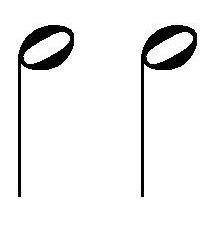 |
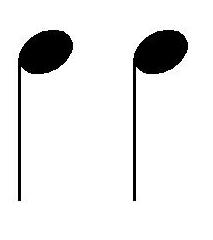 |
6/4 |  |
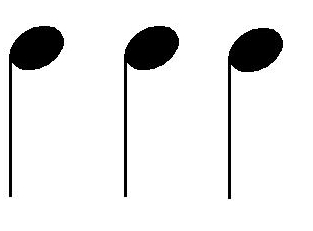 |
| 2/4 |  |
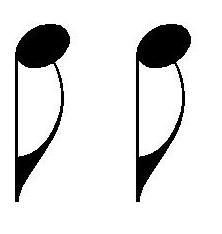 |
6/8 | 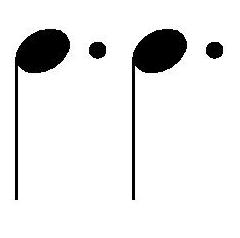 |
 |
| 2/8 |  |
 |
6/16 | 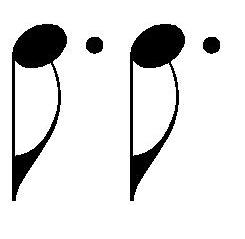 |
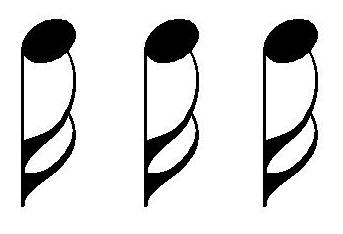 |
| 3/2 |  |
 |
9/4 | 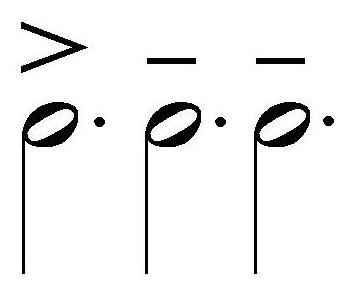 |
 |
| 3/4 |  |
 |
9/8 | 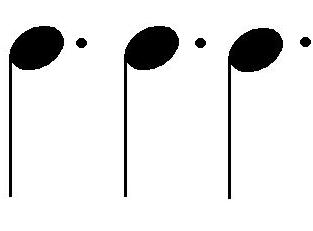 |
 |
| 3/8 |  |
 |
9/16 | 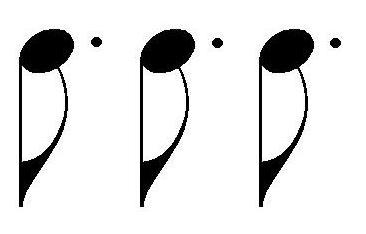 |
 |
| 3/16 |  |
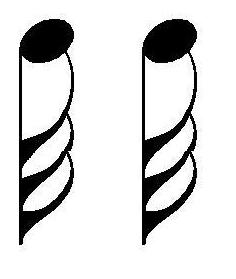 |
9/32 | 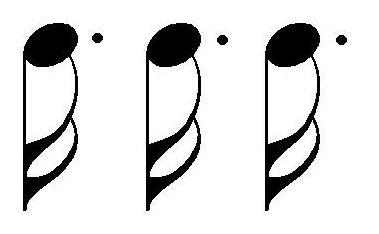 |
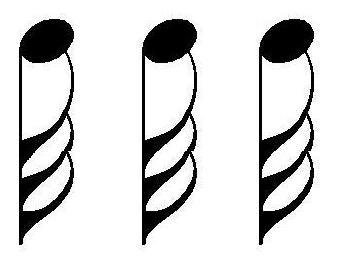 |
| 4/2 |  |
 |
12/4 | 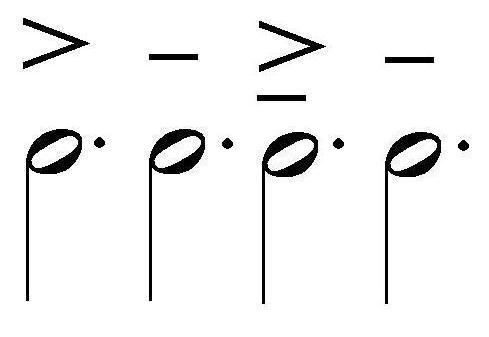 |
 |
| 4/4 | 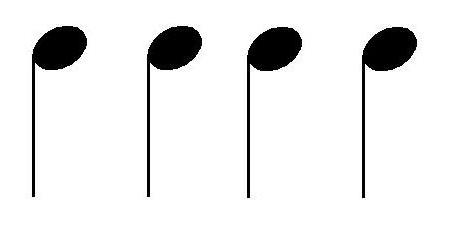 |
 |
12/8 | 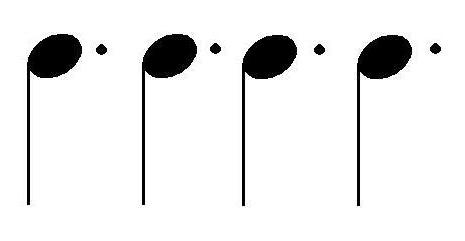 |
 |
| 4/8 | 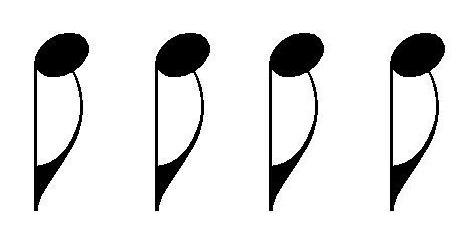 |
 |
12/16 | 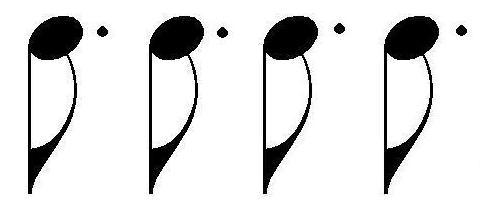 |
 |
| 4/16 | 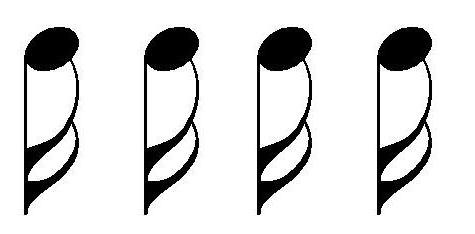 |
 |
12/32 | 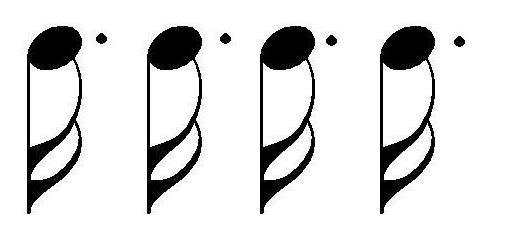 |
 |
| 5/2 | 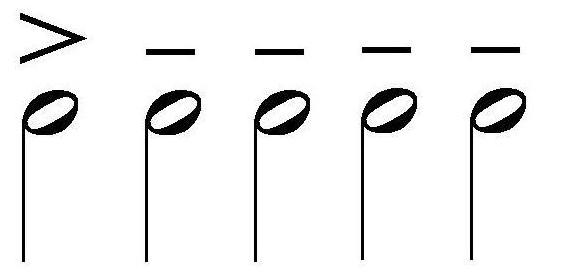 |
 |
15/4 | 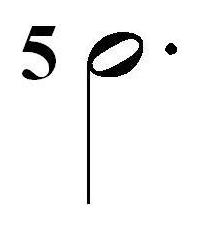 |
 |
| 5/4 | 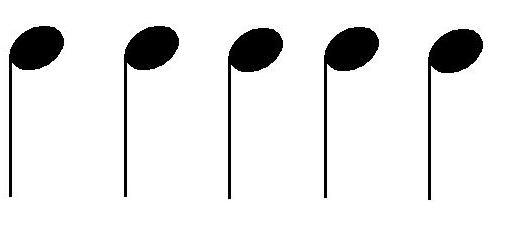 |
 |
15/8 | 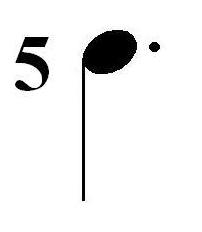 |
 |
| 5/8 | 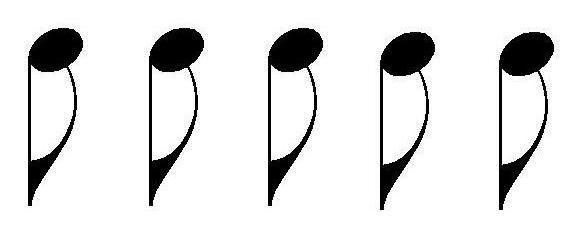 |
 |
15/16 | 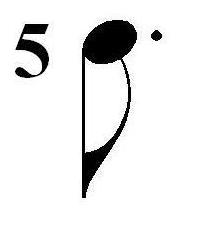 |
 |
| 5/16 |  |
 |
15/32 |  |
 |
| 7/2 | 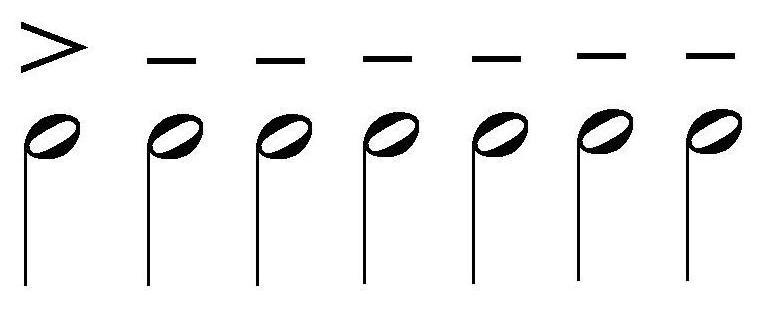 |
 |
7/4 | 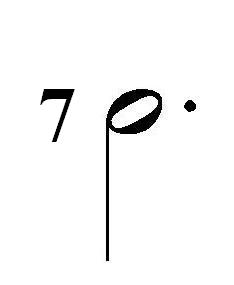 |
 |
| 7/4 |  |
 |
7/8 | 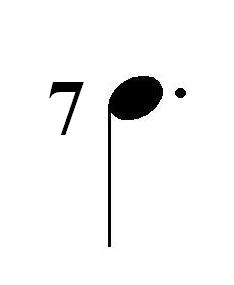 |
 |
| 7/8 |  |
 |
7/16 | 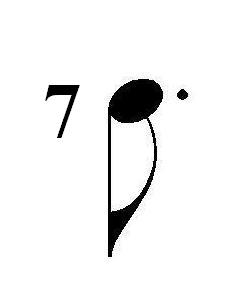 |
 |
| 7/16 |  |
 |
7/32 | 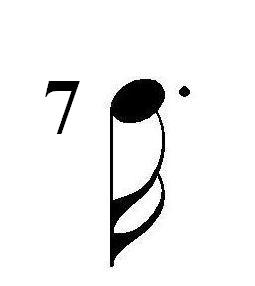 |
 |
(1) The phenomenon of different regular patterns of strong and weak accents gives rise to the study of metre in both poetry and music. See chapter 15.
(2) If the upper number is "3" then the time signature is simple triple time. A time signature is compound if the upper number is any one of the following numbers: 6; 9; 12; 15; 21.
